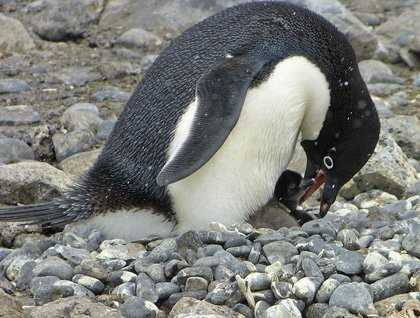Go ahead. Ask me what is the singular, very best day of the entire Antarctic season. I will answer: it is the first day that young penguins leave the safety of their egg and greet the great white world, still tucked warmly and safely under a parent bird. It is the day that the next generation of penguins first make their appearance. It is today, at Brown Bluff.
We landed and left our Zodiacs (sit and spin) to set foot on the Antarctic Continent itself, where we exchanged congratulations. Down the beach, past the incubating gentoo penguins, past the lines of Adèlie penguins heading resolutely down the beach, we reached the dense colony of Adèlies. The nests of stones were packed closely, pecking-distance apart. Most of the birds were lying quietly over their two eggs. Occasionally, birds returning from a feeding foray greeted their mate with a raucous display, and then the two birds switched places, all while carefully protecting their eggs from marauding predators. We watched as incubating birds rose up and revealed their eggs to our eyes and cameras. And then came an excited shriek from one of our guests. She had spotted a small black fuzz ball under the stretching parent, and thus the first young penguin came to our attention. As we watched, we found that more of the nests were hatching. Some of the young penguins were emerging from their shells, half in, half out.
After that stupendous morning, I really felt that I had earned the rest of the day off, but my well-deserved, after-lunch nap was interrupted by the voice of our Expedition Leader telling us that the ship was about to push into the fast ice of Active Sound. What?! Surely they jest. Are they unaware of the fate of Ernest Shackleton and the crew of the Endurance (a story that unfolds in these very waters)? But enter the ice is exactly what we did. Fast ice, or shore-fast ice, is frozen sea, a remnant of the last Antarctic winter, that is attached (as in "made fast to") the shore, in this case to Joinville and Dundee Islands.
This is what National Geographic Explorer is all about: the ability to explore the ice with adventure and with safety. She made her own berth in the ice. After testing it (it was four feet thick) we stepped off for a stroll over the ice and the water below (all 764 meters of it; that is 2,500 feet, or nearly half a mile to the ocean bottom.) What an experience! It seemed that we were the prime attraction for groups of Adèlie penguins who couldn't resist coming over for a visit, alternately walking and tobogganing on their rotund bellies, pushed forward by legs and flippers and leaving distinctive tracks in the snow. They even joined us as we gathered for grilled Polish sausage and cold beer on the ice.
We—those of us who have been here many times and keep coming back for more—feed off your excitement, your sense of wonder. May you never lose it.









